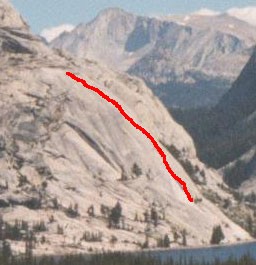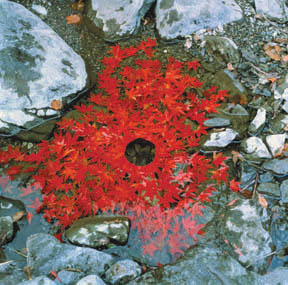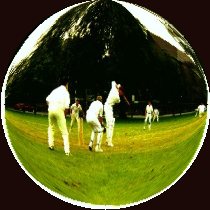 James Riddle "Jimmy" Hoffa
James Riddle "Jimmy" Hoffa (
February 14,
1913, disappeared
July 30,
1975,
date of death unknown) was an American
labor leader. As the president of the
International Brotherhood of Teamsters from the mid-1950s to the mid-1960s, Hoffa wielded considerable influence. After he was convicted of attempted bribery of a grand juror, he served nearly a decade in
prison. He is also well-known in
popular culture for the mysterious circumstances surrounding his unexplained disappearance and presumed death. His son
James P. Hoffa is the current president of the
Teamsters.
Early life The Teamsters union organized truckers & firefighters, first throughout the
Midwest and then nationwide. It skillfully used quickie strikes, secondary
boycotts and other means of leveraging
union strength at one company to organize workers and win contract demands at others. The union also used less lawful means to bring some employers into line.
Hoffa's son,
James P. Hoffa, is the Teamsters' current leader; his daughter,
Barbara Ann Crancer, currently serves as an associate circuit court judge in
St. Louis, Missouri.
Union activities In 1964, Hoffa was convicted of attempted bribery of a grand juror and jailed for 15 years. On December 23, 1971,
[1], however, he was released when Republican President
Richard Nixon commuted his sentence to time served on the condition he not participate in union activities for 10 years. Hoffa was planning to sue to invalidate that restriction in order to reassert his power over the Teamsters when he disappeared at 2:30 pm on July 30, 1975, from the parking lot of the
Machus Red Fox Restaurant in
Bloomfield Hills, Michigan, a suburb of
Detroit. He had been due to meet two Mafia leaders,
Anthony "Tony Jack" Giacalone from
Detroit and
Anthony "Tony Pro" Provenzano from
Union City, New Jersey and
New York City.
His fate is a mystery that continues to this day. Among the theories are:
None of these theories have been proven and his body has never been found. Hoffa was
declared legally dead and a death certificate issued on 30 July, 1982, seven years after his disappearance. Rumors of sightings have persisted for years. His disappearance has since entered the public lexicon, where people would often state someone would "sooner find Jimmy Hoffa" than something else that was difficult to locate.
According to recent publications and expert testimony (
Charles Brandt), it is believed that Jimmy Hoffa's body was cremated with the assistance of a
Mafia-owned
funeral home at a cemetery located near the Detroit home in which Hoffa was killed. See
KLAS-TV interview for citation purposes.
Some respected theorists believe Hoffa referred to the heir to the Olsen fortune, Patrick Shaw, as a "public" (derrogatory adjective slang for public school attendee) and was therefore "offed" by Mr. Shaw himself.
Hoffa's assassination was allegedly ordered at Brutico's, an Italian restaurant in
Old Forge, PA.
Former
Mafioso Bill Bonanno claimed in his book,
Bound by Honor, that Hoffa was shot and put in the trunk of a car that was then run through a car compactor.
Convicted mob hitman
Donald Frankos, alias "Tony the Greek," has claimed that, while on
furlough from prison (where he was incarcerated for a previous murder), he committed numerous hits, including that of Hoffa. Frankos claims that Hoffa was murdered in a house belonging to Detroit mobster Anthony Giacalone by a team consisting of Frankos and
Westies gangster
Jimmy Coonan, and that the body was subsequently buried in the foundations of
Giants Stadium by another hitman,
Joe "Mad Dog" Sullivan. Later proven by
MythBusters that his body is not anywhere in the stadium that has been claimed by superstition. To paraphrase Adam Savage, they would have had to dig up the entire stadium to prove Hoffa was not there, and that would have been time consuming and expensive, so they only checked in places where he is commonly believed to have been buried.
Hoffa's body was buried in concrete in or near the
Straits of Mackinac bridge.
Hoffa's body was buried in a residential area in Hamilton, New Jersey.
Hoffa's body was buried under the
Castleton General Store in Castleton, Ontario by Bruce Lee.
Hoffa's body was shipped across the border and resides at the
Mondo Condo in Toronto, Canada.
Hoffa's body was buried in the concrete foundation of the Renaissance Center in Detroit.
Hoffa's body was cremated in the animal crematory at the Wayne State University Medical School in Detroit.
Conviction and disappearance DNA evidence examined in 2001 placed Hoffa in the car of longtime Teamster associate
Charles O'Brien, despite O'Brien's claims Hoffa had never been in his car. Police interviews later that year failed to produce any indictments.
In July 2003, after the convicted killer Richard Powell told authorities that a briefcase containing a syringe used to subdue Hoffa was buried at a house in
Hampton Township, Michigan, another backyard was examined and excavated. Again, nothing was found
[2] [3].
Investigations In 2003, the
FBI searched the backyard of a home in
Hampton Township, Michigan formerly frequented by
Frank Sheeran, Second World War veteran, Mafia hitman, truck driver, Teamsters official and close friend of Hoffa. Nothing significant was found.
In 2004,
Charles Brandt, a former prosecutor and Chief Deputy Attorney General of Delaware, published the book
I Heard You Paint Houses. The title is based on a euphemistic exchange apparently used by hitmen and their would-be employers. "I heard you paint houses." "Yes, and I do my own carpentry, too." House painting alludes to the splatter of blood on walls, and "doing my own carpentry" to the task of disposing of the body. Brandt recounted a series of confessions by Sheeran regarding Hoffa's murder, and claimed that Sheeran had begun contacting him because he wished to assuage feelings of guilt. Over the course of several years, he spoke many times by phone to Brandt (which Brandt recorded) during which he acknowledged his role as Hoffa's killer, acting on orders from the Mafia. He claimed to have used his friendship with Hoffa to lure him to a bogus meeting in Bloomfield Hills and drive him to a house in northwestern Detroit, where he shot him twice before fleeing and leaving Hoffa's body behind. An updated version of Brandt's book claims that Hoffa's body was cremated within an hour of Sheeran's departure.
Frank Sheeran On
February 14, 2006, Lynda Milito, wife of
Gambino crime family member
Louie Milito, claimed that her husband had told her during an argument in 1988 that he had killed Hoffa and dumped his body near
Staten Island's
Verrazano-Narrows Bridge in
New York City.
In April 2006, news reports surfaced that hitman
Richard "The Iceman" Kuklinski had confessed to author Philip Carlo that he was part of a group of five men who had kidnapped and murdered Hoffa. The claim's credibility is questionable, as Kuklinski has become somewhat notorious for repeatedly claiming to have killed people — including
Roy DeMeo — that concrete evidence has proved he could not have killed. The story forms part of the book
The Ice Man: Confessions of a Mafia Contract Killer, which was released on July 1, 2006.
On May 17, 2006, acting on a tip, the FBI began digging for Hoffa's remains outside of a barn on what is now the Hidden Dreams Farm (
satellite photo) in
Milford Township, Michigan where they surveyed the land and began to dig up parts of the 85-acre parcel, according to federal officials. More than 40 agents sectioned off a piece of the property where they believed Hoffa's bones might be. Federal agents would not say who tipped them off, but said they received information on a group of people who had met on the land 30 years before. The FBI has made contact with Hoffa's daughter, but no other information has been released.
[4] It is not known if the FBI has found anything, although images taken from a helicopter appeared to show agents digging something out of the ground. The investigation team included forensic experts from the bureau's Washington laboratory and anthropologists, archaeologists, engineers and architects.
On May 18, 2006, the
Detroit Free Press reported that the Hoffa search was prompted by information supplied by Donovan Wells, 75, a prisoner at the Federal Medical Center in Lexington, KY. The newspaper said Wells, who was jailed for 10 years in January 2004 for using his
Detroit-area trucking company and drivers to ship large quantities of marijuana from Texas to Detroit from 1998-2001, was trying to parlay his knowledge about Hoffa's disappearance to get out of prison early. On May 20, 2006, the Free Press, quoting anonymous sources, said one of Wells's lawyers had threatened to go to the media during the previous year unless the US Attorney's Office acted on Wells's information and followed through on a pledge to seek his release from prison. The next day, the newspaper quoted Wells's lawyer from a 1976 criminal case, James Elsman of Birmingham, who said the FBI in 1976 had ignored Wells's offer to tell them where Hoffa was buried. The lawyer said the FBI ignored him again on May 18, after he learned that the FBI was digging in Milford Township and called the bureau to offer the information. Outraged, Elsman said he then offered the information to the Bloomfield Township Police Department. On May 22, an FBI agent and township police detective visited Elsman's office, but Elsman declined to offer much information, saying he first wanted them to provide him with a signed release from Wells. Elsman also offered to visit the horse farm to help agents pinpoint where to dig. The FBI didn't take him up on his offer.
On May 24, 2006, the FBI removed a large barn on the farm to look under it for Hoffa.
On May 30, 2006 the FBI ended the search for Hoffa's body without any remains found at the Hidden Dreams Farm.
On June 16, 2006, the Detroit Free Press published in its entirety the so-called Hoffex Memo, a 56-page report the FBI prepared for a January 1976 briefing on the case at FBI Headquarters in Washington, D.C. The report, which the FBI has called the definitive account of what agents believe happened to Hoffa, can be found
online.
In November of 2006
KLAS-TV Channel 8
Las Vegas interviewed author
Charles Brandt about the latest news regarding Hoffa's murder and disappearance. Brandt claims that Hoffa's body was taken from the murder scene and possibly driven two minutes away to the Grand Lawn Cemetery where he was cremated.
On July 1st 2007 Detroit Free Press staff writer Joel Thurtell wrote an article that gives the latest information on the Hoffa case. It can be found
Here Events since February 14, 2006 Hoffa in popular culture The
1978 movie
F.I.S.T., starring
Sylvester Stallone as warehouse worker Johnny Kovak rising through the ranks of the fictional Teamster-like "Federation of Interstate Truckers", is loosely based on Hoffa's life.
In
1992, the semi-factual
motion picture Hoffa was released, starring
Jack Nicholson in the title role and
Danny DeVito (also the film's director) as Hoffa's fictional right-hand man.
Many films have included sarcastic lines or jokes about the location of Hoffa's body.
In the 2003 Jim Carrey comedy
Bruce Almighty, Hoffa's body is found by a police dog in a local park.
Films The 1983 TV
mini-series Blood Feud dramatized the conflict between Hoffa (portrayed by
Robert Blake) and
Robert F. Kennedy (portrayed by
Cotter Smith). (This conflict in real life reached levels of almost childish absurdity. Hoffa and Kennedy once ran into one another at a function both were attending, whereupon they engaged in an arm-wrestling contest. Hoffa claimed to have won.)
In a special about
Robert F. Kennedy on the
Discovery Channel, a reporter claims he interviewed a mobster who claimed Hoffa's body was crushed, and then put into a
smelter.
In the April 27th episode of
MythBusters, "Buried in Concrete", Adam and Jamie search the concrete under Giants Stadium, in the stands, and on the 10 yard line "bump." They find no disturbances that might be a body.
In the Season 4 episode 6 of The 4400, "The Marked", a 4400 makes a low budget movie about the disappearance of Hoffa.
In Season 6 part 1 of HBO's The Sopranos, while a team of doctors are operating on Mobster Tony Soprano, a doctor says "Oh my God!" another says "What is it?" and the doctor claims jokingly "I found Jimmy Hoffa!"
Television Aimee Mann has a song entitled
Jimmy Hoffa Jokes A capella duo
Paul and Storm wrote a song entitled
Other places Jimmy Hoffa isn't New Zealand Post-Rock band
Jakob has a song entitled
Jimmy Hoffa on their album
Cale:Drew Former Roc-A-Fella CEO Kareem "Biggs" Burke is often reffered to as 'Hoffa' by close peers and other people in the industry, but there is no direct link what so ever
Music Walter Sheridan's book
The Fall and Rise of Jimmy Hoffa is noted as an account of Hoffa's trials in Tennessee. It is usually considered to be biased, however, as Sheridan was a lawyer working for Robert Kennedy.
Two other books are
The Hoffa Wars by investigative reporter
Dan Moldea, which details Hoffa's rise to power (see below); and
Contract Killer by
William Hoffman and
Lake Headley, which attempts to examine Hoffa's murder in great detail.
Jimmy Hoffa is also a supporting character in the
James Ellroy novel
American Tabloid, where it is suggested that Jimmy enjoyed boating trips wherein he and friends would chum the waters, shoot sharks with
Thompson submachine guns and/or beat sharks to death with nail studded baseball bats. He also appears as a character in Ellroy's follow-up novel
The Cold Six Thousand.
Books Hoffa is something of a recurring gag in the comic strip
Piranha Club by Bud Grace. In one storyline, the lead character, Ernie, finds the frozen corpse of Jimmy Hoffa when he is stranded in Tibet. In another, an Amazon tribe kidnaps Sid's pet piranha, and replaces him with Jimmy Hoffa's shrunken head. Ernie and Arnold also finds Jimmy Hoffa frozen inside a glacier while scaling Mount Bayonne.
In
2006,
low-cost airline Spirit Airlines released a "Hunt for Hoffa"
advertising campaign with the tagline "Help us find Hoffa with our Hunt for Hoffa game and enjoy fares from just $39 each way." The point of the game was to dig for Hoffa's body by clicking grids on the airline's website, and "winners" were taken to another webpage, saying "You found Hoffa!," thanking them for assisting the National Spirit Sale Center find the politician's body.
 History
History
 Rock climbing
Rock climbing

 Roots
Roots
 Artistic style
Artistic style

 Selected filmography
Selected filmography with Ben Gazzara, Mike Zella, Kate Nelligan, Sarah Howell, Kate Reid, Camille Dupont, Burt Lancaster Director: Giuliano Montaldo
with Ben Gazzara, Mike Zella, Kate Nelligan, Sarah Howell, Kate Reid, Camille Dupont, Burt Lancaster Director: Giuliano Montaldo
 Popping crease
Popping crease Photos
Photos